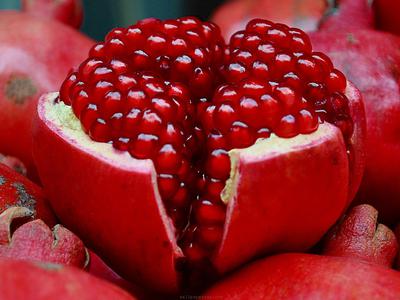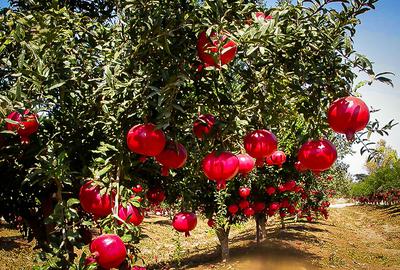VANILLA BEANS | SOYBEAN OIL | SOYA CAKE | COCOA BEANS | COFFEE BEANS
How to grow POMEGRANATE in Uganda

Pomegranate Fruit in Uganda
Pomegranate is an attractive tropical shrub with showy flowers and colorful fruits.
The shrub is locally known as “Enkomamawanga” and is easy to grow as they don’t need much water or fertilizer.
This shrub is an excellent ornamental tree or shrub for home landscaping.
Common Pomegranate varieties in Uganda
Red silk pomegranate - has medium to large size fruit with a pink red exterior
Pink satin pomegranate - has a medium to large size, bright red fruit with small, light pink edible seeds.
Ever sweet pomegranate - this is virtually a seedless type of pomegranate, and its pulp is very sweet.
Wonderful pomegranate - this is one of the early bearing variety producing large purple red fruits with a glossy appearance.
Contact us here to buy Pomegranate fruits and Pomegranate Seedlings/cuttings in Uganda
Soil requirements for growing pomegranate plants
Deep, loamy, well drained soils are preferred but the pomegranate has some tolerance to less than ideal drainage and to mild alkaline condition. The preferable Ph is 5.5 to 7.2.
How to Propagate pomegranate plants on your farm
Propagation can be by seed or cuttings.
We however advise that you use cuttings for faster growth and fruit variation, as plants does come true from seed. Pomegranates are commercially propagated from hard wood cuttings 10 to 20 inches long, treated with a rooting hormone used to ensure development. Air layers are also possible. Seed germinate easily but often produce unreliable results.
Contact us here to buy Pomegranate fruits and Pomegranate Seedlings/cuttings in Uganda
How to plant pomegranate in Uganda
Cuttings are the easiest and the most satisfactory method of growing pomegranates.
Cuttings preferably from 2yr old trees should be used.
Cut straight twigs 8 to 10 inches at a time when the tree is dormant. Place the cuttings in a rooting hormone and then in to a well prepared potting soil.
Water regularly to keep the cuttings moist. In 8 to 16 weeks, the cuttings shall have rooted.
At this time, you can plant the sprouted cuttings as individual landscaping shrub or in rows 8 to 10 ft a part for fruit production, or even as wind breaks.
Prune the trees to encourage faster fruit production. Watch out for whitefly, thrips, mealy bugs and scales as these cause foliar damage.
Contact us here to buy Pomegranate fruits and Pomegranate Seedlings/cuttings in Uganda
How best to Harvest your pomegranates in Uganda
Pomegranate seedlings start bearing at the age of 3-4 yrs for trees sown from seed and 2-3 yrs for cuttings.
The pomegranate stem is thick and strong so remove the fruit by clipping.
Contact us here to buy Pomegranate fruits and Pomegranate Seedlings/cuttings in Uganda
About Marketing pomegranate fruits
The market seeks relatively blemish free, medium to large fruit, with plenty of red color evident, both externally and in the juicy sub acidic pulp surrounding each seed.
Quick Tip for planting pomegranates in Africa
- Clear up area meant for planting the pomegranate.
- Open up a width the same as the root ball of the pomegranate seedling.
- At 10 weeks in the bed go ahead to transfer the seedlings in to its Permanente space.
- Mulch to keep the ground moistened.
Contact us here to buy Pomegranate fruits and Pomegranate Seedlings/cuttings in Uganda
Join in and write your own page! It's easy to do. How? Simply click here to return to Plants Guide.
Haven't yet found what you Want...?
If you haven't yet found what you were looking for or you need detailed information about the subject matter on this page then... feel free to ask our business travel consultants. |







